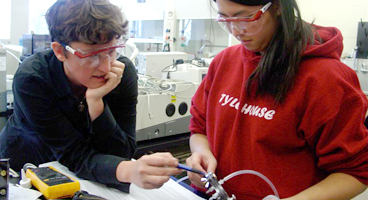Document Type
Article
Publication Date
3-1-2012
Publication Title
Ear and Hearing
Abstract
Objective: Reflectance measured in the ear canal offers a noninvasive method to monitor the acoustic properties of the middle ear, and few systematic measurements exist on the effects of various middleear disorders on the reflectance. This work uses a human cadaver-ear preparation and a mathematical middle-ear model to both measure and predict how power reflectance R is affected by the middle-ear disorders of static middle-ear pressures, middle-ear fluid, fixed stapes, disarticulated incudostapedial joint, and tympanic-membrane perforations. Design: R was calculated from ear-canal pressure measurements made on human-cadaver ears in the normal condition and five states: (1) positive and negative pressure in the middle-ear cavity, (2) fluidfilled middle ear, (3) stapes fixed with dental cement, (4) incudostapedial joint disarticulated, and (5) tympanic-membrane perforations. The middle-ear model of Kringlebotn (1988) was modified to represent the middle-ear disorders. Model predictions are compared with measurements. Results: For a given disorder, the general trends of the measurements and model were similar. The changes from normal in R, induced by the simulated disorder, generally depend on frequency and the extent of the disorder (except for the disarticulation). Systematic changes in middle-ear static pressure (up to ±300 daPa) resulted in systematic increases in R. These affects were most pronounced for frequencies up to 1000 to 2000 Hz. Above about 2000 Hz there were some asymmetries in behavior between negative and positive pressures. Results with fluid in the middle-ear air space were highly dependent on the percentage of the air space that was filled. Changes in R were minimal when a smaller fraction of the air space was filled with fluid, and as the air space was filled with more saline, R increased at most frequencies. Fixation of the stapes generally resulted in a relatively small low-frequency increase in R. Disarticulation of the incus with the stapes led to a consistent lowfrequency decrease in R with a distinctive minimum below 1000 Hz. Perforations of the tympanic membrane resulted in a decrease in R for frequencies up to about 2000 Hz; at these lower frequencies, smaller perforations led to larger changes from normal when compared with larger perforations. Conclusions: These preliminary measurements help assess the utility of power reflectance as a diagnostic tool for middle-ear disorders. In particular, the measurements document (1) the frequency ranges for which the changes are largest and (2) the extent of the changes from normal for a spectrum of middle-ear disorders.
Volume
33
Issue
2
First Page
195
Last Page
208
DOI
10.1097/AUD.0b013e31823235b5
ISSN
01960202
Version
Author's Accepted Manuscript
Recommended Citation
Voss, Susan E.; Merchant, Gabrielle R.; and Horton, Nicholas J., "Effects of Middle-Ear Disorders on Power Reflectance Measured in Cadaveric Ear Canals" (2012). Engineering: Faculty Publications, Smith College, Northampton, MA.
https://scholarworks.smith.edu/egr_facpubs/70


